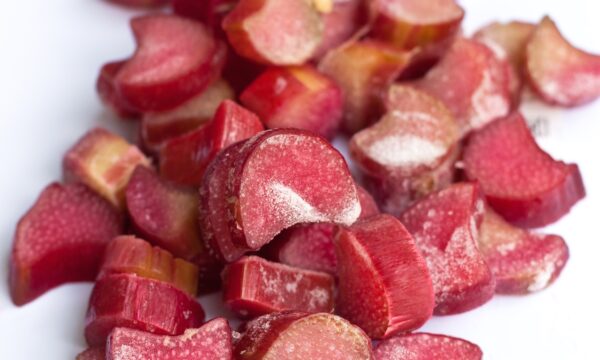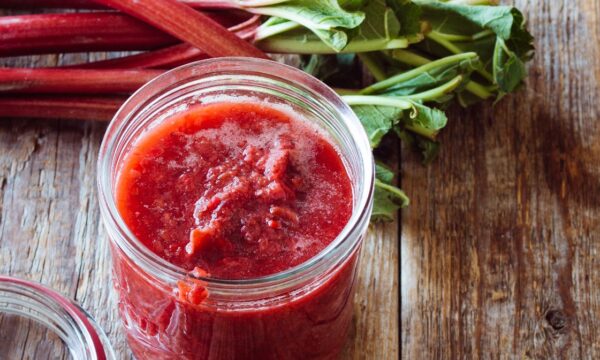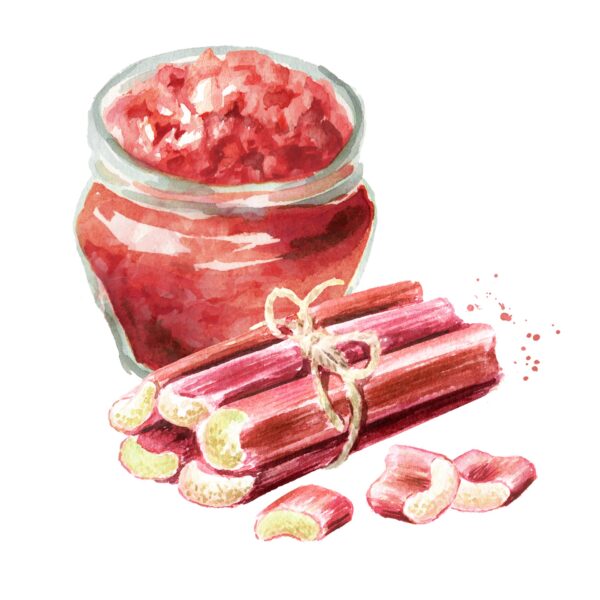Growing up in a small town in the Midwest, we neighbor kids were quite familiar with the odd celery-like stalk with an enormous leaf at the end of it. Rhubarb lined one side of a neighbor’s house like decorative landscaping. We’d break off a shaft of it and dip it in a cup of sugar with each bite to soften the sour.
In the days before calling 911 over unsupervised children, the adults simply shouted over their shoulders, “OK, dear, just don’t eat the leaves; they’re poisonous.” That seemed to be sufficient warning. But are they really?
Oxalic acid, which occurs in many vegetables, fruits, and even cocoa, is the offending culprit. It’s also found in the rhubarb stalk, but it’s the higher concentrations in the leaves that prompt the warning.
Too much can enter the toxic zone, giving one a bellyache or in worse cases, vomiting or diarrhea. Farther down the list are kidney stones and kidney failure, which is quite serious. Individuals with certain medical conditions may need to be more concerned about oxalic acid amounts.
But the idea of kids munching down on large bitter leaves seems unlikely, when they’re typically reluctant to even eat a small leaf of spinach at the dinner table.
At any rate, you shouldn’t eat the leaves, and neither should your pets.
Harvest Time
Rhubarb can come in as early as April and will be done by the end of June. Don’t harvest a new plant in the first season; let its roots strengthen for a year. Hothouse rhubarb, grown in greenhouses, may also be available as early as January; its flavor is milder but the flesh is less stringy. The stringiness is irrelevant when you’ve cooked it all down anyway.
Take stalks that are at least a half-inch thick and eight inches long, but be aware that when they grow thicker than an inch, they start to get woody. Don’t let the color fool you: While the reddish tint may look as if it is ripe compared to the light green, the hue is irrelevant.
At the base of the stalk, twist and break it free without damaging the central mass and roots of the plant. Also, take only about a third of the stalks; don’t clear it all out, or the plant might not survive for next year. Throw away the leaves or compost them.
You can keep the stalks in the crisper of your fridge for a few weeks, but don’t let them dry out or absorb moisture. You can also freeze them in an airtight bag, squeezing out any extra air. I chop them into pieces first. It’s best not to leave them for more than a year.

Eating Rhubarb
If you have any left over after munching on it raw, rhubarb makes some killer pies. I am most definitely a rhubarb purist; I prefer to leave the rhubarb alone at center stage. I find its unique flavor gets overshadowed by the brightness of other fruits such as strawberries, a common partner in pies, though a layer of custard seems to work out well.
Rhubarb sauces and chutney are also nice, but my favorite way to stretch the rhubarb season is jam. Pure rhubarb jam. (However, I do occasionally allow for adding candied and fresh ginger, which frankly go with about any jam I’ve made.)

One cup of sugar for every pound of the tart rhubarb is typical. Rhubarb is short on pectin, a natural starch in fruits and veggies that helps thicken jam when you’re cooking it. So some recipes may call for it as a separate ingredient, which should be easily found at the grocery store in the baking aisle. But I have yet to use it.
Rhubarb Jam

Makes about four 8-ounce jars
- 2 pounds rhubarb stalks, chopped in 1/4-inch pieces
- 2 cups sugar
- 1 tablespoon lemon juice
To draw out more of rhubarb’s natural pectin, work the sugar into the rhubarb first and let it rest for as long as you’re patient, even overnight. The juices will come out and dissolve the sugar, prepping it with pectin.
When you’re ready, heat this mass in a saucepan over medium heat for about 20 minutes. It will boil, and you should stir frequently to prevent burning. Use a spoon to skim any froth that rises to the top and discard that.
Now watch for the next 15 to 20 minutes as the jam begins to thicken. It may seem runny when it is near boiling, but as it cools, it thickens. To test it, I dip the back of a spoon in the mix to see what sticks, set it inside the freezer on a plate for a minute to let it cool and set, and then judge if it is thick enough. It will wrinkle up when you poke at it. As for thickness, I say there’s no wrong answer here: I’ve quit too soon and had the most delicious runny jam for my toast.
When it’s ready, fill sterilized jam jars to within 1/4 inch of the top, cover with canning lids, and give them a 10-minute hot water bath. Allow the jars to cool overnight. You’ll hear them pop almost immediately as they cool and seal.
They say these keep for a year or more, but honestly, I find a jar is gone in about a week. Refrigerate once you open them.
Kevin Revolinski is an avid traveler, craft beer enthusiast, and home cooking fan. He is the author of 15 books, including “The Yogurt Man Cometh: Tales of an American Teacher in Turkey” and his new collection of short stories, “Stealing Away.” He is based in Madison, Wis., and his website is TheMadTraveler.com
 RSS Feed
RSS Feed















 April 23rd, 2021
April 23rd, 2021  Awake Goy
Awake Goy  Posted in
Posted in  Tags:
Tags: 













